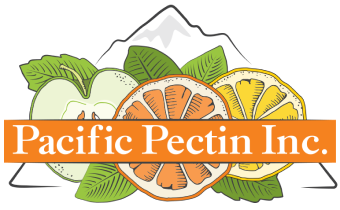Your Pectin Partner Since 1986
Gummy Pectin Crash Course
Master the art of gummy making with our comprehensive gummy pectin guide. Learn professional techniques for perfect texture and stability for your candy and gummies.
Course Outline
CHAPTER 1: THE SWEET BEGINNING
What Is Pectin?
Pectin is a nature-based ingredient solution! It is a natural polysaccharide found in the cell walls of plants. It’s most abundantly found in citrus peels and apple pomace. In the world of gummy making, pectin is the catalyst that gives our gummies their signature chewy texture. It’s 100% plant-based, making it a perfect choice for everyone, including those just simply wanting to live and feel well, vegans, vegetarians, and those with dietary restrictions.
Visibly, pectin appears as a white to light beige powder. Until recently, pectin was used as a gelling agent in jams and jellies across the globe. Nowadays, pectin is not only used in creating a perfect gummy (along with jams and jellies), but is also used in fillings, medicines, fruit juices, milk drinks, and as a source of dietary fiber.
Why Pectin Over Gelatin?
While gelatin is derived from animal bones, pectin comes from citrus fruit peels. Pectin gummies offer a more appealing, often described as more natural and fruit-like, texture compared to gelatin gummies.
Choosing pectin over other gelling agents is advantageous for several reasons. Pectin not only helps maintain the natural flavor of products but also aligns with organic and natural labeling claims. Pectin is currently tied to multiple emerging trends including non-GMO, vegan, and non-gelatin claims. It’s a clean-label, plant-based product! Pectin-based gummies provide a cohesive and firm texture, ensuring a satisfying bite. Additionally, they excel in factors such as flavor release, acid stability, pH working range, and heat stability, making pectin a superior choice for gelling compared to other alternatives. Gelatin also tends to melt at higher temperatures, making it hard for manufacturers to ship their gummies without them melting in their packaging.
Is Pectin Hard to Work With?
Making gummies can be perceived as challenging, but it’s more of an art form. Challenges may arise during the setting process if the correct procedure is not followed. However, by diligently adhering to our recommended steps, especially regarding cooking temperature, sugar and citric acid levels, and proper cooling, you can overcome any difficulties and achieve the perfect gummy outcome.
CHAPTER 2: PECTIN AND GUMMIES – A MATCH MADE IN HEAVEN
The Science of Gummy Making
Gummy making beautifully marries science with art, a precise yet creative process that yields those irresistible chewy treats we all adore. While there’s always a temptation to experiment, adhering to the established gummy pectin procedure is essential for crafting the perfect gummy.
At the heart of gummy creation is pectin’s affinity for water. Pectin molecules have a unique talent for capturing water and transforming it into a gel, which is foundational to the body and texture of a gummy. It’s this intricate dance between pectin, sugar, and acid, when executed with precision, that brings to life the chewy delights that captivate our taste buds. Embracing this process, with its scientific precision and artistic flair, is the key to unlocking the full potential of your gummy-making endeavors.
The Two Different Types of Pectin
High Methoxyl (HM) Pectin:
What It Is: A type of pectin with more than 50% of its carboxyl groups esterified with methanol.
Gelation Properties: High soluble solids content (typically sugar) and acidic conditions are needed. Soluble solids (brix) must exceed 55%, and the pH should be between 2.8 and 3.5 to form a gel.
Best For: Producing traditional jams, jellies, and gummies that are sweet and have a firm to spreadable texture.
Key Features: Gel formation is dependent on sugar and acidity, making it ideal for sweet, acidic products.
Low Methoxyl (LM) Pectin:
What It Is: A type of pectin with less than 50% of its carboxyl groups esterified, meaning it has fewer methoxyl groups.
Gelation Properties: Forms a gel in the presence of calcium ions, without the need for high soluble solids. The soluble solids (brix) range is 0% – 50%, and the pH should be between 2.8 and 3.5 to form a gel.
Best For: Creating reduced-sugar or sugar-free preserves, offering a wider range of flavors and textures, including those that are health-oriented.
Key Features: Offers flexibility in sugar content for gelation, allowing for innovation in texture, flavor, and nutritional content.
Simplified Comparison:
HM pectin requires both sugar and acid to gel, making it ideal for sweet and sour treats. In contrast, LM pectin relies on calcium rather than sugar content, allowing for more diversity in sweetness and flavor profiles.
What does this mean for Gummies?
When it comes to gummy production, High Methoxyl (HM) pectin stands out as the optimal choice.
Gummies typically have a high soluble solids content— often around 80 brix, which is significantly above the 55% threshold required for HM pectin to gel. The high brix not only helps HM pectin form a firm gel but also contributes to the chewy and stable texture that defines gummies.
While Low Methoxyl (LM) pectin excels in low-sugar or sugar-free preserves, it isn’t well-suited for traditional gummy production. LM pectin requires calcium ions for gelation, which introduces complexities in controlling the gel strength and consistency in high-sugar environments.
Final Takeaway
For gummy manufacturers, HM pectin is the ideal choice for creating consistent, high-quality gummies that consumers love. Its ability to gel under high brix and low pH conditions, combined with its superior textural qualities and stability, makes HM pectin the perfect choice.
CHAPTER 3: CRAFTING YOUR GUMMY MASTERPIECE
Selecting the Right Ingredients for Gummy Making
- Pectin Choices – Dive into gummy making with our industry-leading pectins – HM-100, HMA-100, and Sugar-Free Gummy Pectin. These signature blends are designed to streamline your process, ensuring success from the start.
- The Role of Sugar – Sugar isn’t just sweet; it’s essential. It works in harmony with pectin, activating its gelling powers to give gummies their iconic texture.
- Stability with Inverted Sugar– Incorporate inverted sugars like honey, corn syrup, or glucose syrup to keep your gummies shelf-stable. This prevents the formation of an unwelcome hard crust over time.
- Water – A Must-Have: Water is the unsung hero, preventing your mix from becoming a burnt and sticky disaster. It’s essential for a smooth, manageable process.
- Acid – The pH Perfecter: Citric acid is our preferred choice for nailing that perfect pH, but feel free to explore alternatives like ascorbic, malic, or fumaric acid to achieve the desired acidity.
- Flavorings – Your Creative Canvas: This is where you can let your imagination run wild, tailoring your gummies to current market trends or timeless favorites.
- Coatings – The Final Touch: Explore a variety of coatings – from granulated to powdered sugar, citric acid, corn starch, neutral oils, and carnauba wax. These not only add texture and flavor but also make your gummies visually distinctive.
- Vitamins/Minerals – The Special Ingredients: If you’re aiming for a health-focused niche, adding vitamins or minerals can be a game-changer. Just remember, these additions can alter the pH, so adjustments may be necessary.
Stand out in quality and appeal! Keep these guidelines in mind to craft gummies that will delight and satisfy your target audience.
Creating a Gummy Recipe
Pectin Usage: 4 – 5% of total batch weight
Finished Brix 78 to 84 and final pouring pH of 3.4
A typical batch starting point is…
- 45% Sugar
- 24% Water
- 20% Corn Syrup
- 4% Pacific HM-100 Pectin (Our go-to, user-friendly gummy pectin)
- .4% Citric Acid
Beginning with a 4% usage of HM-100 pectin is a solid starting point. If you’re aiming for a firmer texture, consider increasing the pectin to 5%, but be mindful to adjust the citric acid accordingly to maintain the desired final pH level.
Using 24% water is recommended to ensure your pectin hydrates within a safe Brix range, ideally not surpassing 30% Brix. Should you decide to use less water, vigilance is required to keep the hydration Brix in check.
Incorporating corn or tapioca syrup is essential, as it not only enhances the firmness of your gummy but also contributes to its shelf stability. It’s important not to reduce syrup content below 20%. Should you wish for a firmer gummy, increasing the syrup will achieve this, though it will also make the cooking solution more viscous.
Sugar, constituting 51.45% of your recipe, is adjustable based on modifications to other ingredients. For instance, upping the pectin to 5% means you’ll need to decrease sugar to 50.45%. It’s worth noting that alternative sweeteners like dextrose, maltitol, allulose, and polydextrose can also serve as your sugar source, offering flexibility in crafting your gummy’s flavor profile and nutritional content.
Adjusting the citric acid in your gummy recipe is key to achieving the perfect final pH of 3.4. It’s a delicate dance as decreasing the amount of citric acid will lead to a higher pH, while increasing it will lower the pH. It’s important to keep in mind that introducing additional ingredients, especially certain vitamins and minerals, can impact your pH. Therefore, be prepared to tweak the citric acid content to compensate for these changes and maintain that ideal pH balance. This nuanced adjustment ensures your gummies not only taste great but also have the perfect texture and consistency.
CHAPTER 4: TROUBLESHOOTING TIPS
Balancing pH and Brix Levels
Reiterating the importance of pH and Brix levels can’t be overstated. If your gummies aren’t quite right, these two metrics are your first checkpoints. Adjust your recipe’s soluble solids or acidity as needed to align with the ideal parameters.
Gummies Won’t Set?
The culprits here are often not enough sugar or too low cooking temperatures. Achieving the right temperature is key; we recommend induction burners for their precision. Ensuring your mixture hits the necessary temperature is critical for the perfect set.
Gummies Too Soft?
This problem usually arises from low pectin levels or overly extended cooking times. Gummy recipes that take over an hour from start to finish may require more pectin. For more insights, our FAQ page covers soft gummies in depth.
Gummies Too Hard?
If your gummies are turning out harder than expected, look at your syrup usage. Without enough syrup (below 20%), gummies harden significantly over time. For immediate firmness issues, adjusting the syrup to 25% and tweaking the pectin levels can help reach the desired texture.
Gummies Too Bitter?
Bitterness, especially in CBD/THC, vitamin, or medicated gummies, often stems from specific ingredients. Using flavor modifiers or bitter blockers can mitigate this, improving taste and consumer satisfaction.
Gummies Too Wet and Sticky?
Tackiness usually points to a high pH level. Ensure your final pH is at or below 3.5. After demolding, if gummies feel sticky, let them cure for 24 hours in an environment with 30-35% humidity and at 70°F. Rushing into packaging can trap moisture, leading to a wet appearance.
Gummies Sticking to Molds?
A light application of food-grade mold release spray or coconut oil on your molds can prevent sticking. Always wait for the gummies to fully set before removing them to avoid damage and maintain shape.
CHAPTER 5: BEYOND THE BASICS
Creative Flavors and Shapes
The real fun begins when you start experimenting with flavors and shapes. Blend mango and passion fruit juice for a tropical twist, or use rosewater for a floral note. Silicone molds come in all shapes and sizes, from bears to hearts, allowing you to personalize your gummies further. We highly recommend checking out Dark City Molds as they provide premium, custom molds!
Advanced Techniques (For Those Looking to Elevate Their Gummy Game)
Layering: Create layered gummies by setting one flavor before adding another on top.
Fillings: Experiment with liquid centers for a surprise burst of flavor.
Ask Questions!
Diving into the world of gummy making can raise questions, and we’re here with answers! Reach out with your queries, and let’s demystify the process together.
Have Recommendations?
We’re dedicated to simplifying pectin for you, offering tailored resources and support. Share your curiosities with us, so we can better guide your exploration and make your pectin journey more enriching and straightforward.
Ready, Set, Gummy!
Thank you for joining us on this sweet exploration through the world of pectin gummies. We hope this crash course has ignited your passion for gummy making and empowered you with the knowledge to experiment fearlessly. Remember, the essence of making gummies lies in the joy of creation—mixing a bit of science with a lot of love. So, grab your ingredients, and let’s make some gummy magic happen!




